Hippotherapy in the Woods
Therapeutic horseback riding cures more ills than you’d imagine
Text and Photos by John Pint -- VERSION EN ESPAÑOL
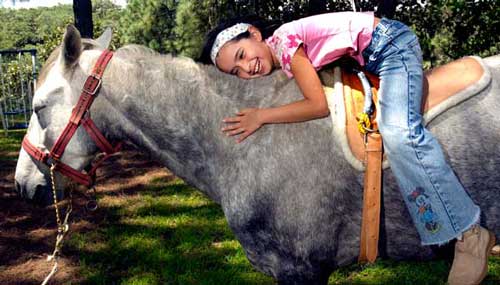
I was sitting in the dentist’s chair carrying on the typical sort of
“conversation” one sometimes has with a dentist: he was doing all the talking
and I would grunt during the appropriate pauses.
“I have purchased three horses and I’m doing Equinoterapia on my property
at the edge of the Bosque de la Primavera,” said Dr. Pepe Herrera. My mouth
stuffed with a gooey plaster cast, I could only reply with muffled croaks to
indicate that I’d like to see what it’s all about. To my surprise, he understood
me—as only a dentist could.
Hippocrates and Therapeutic Riding
Well, I had to do a bit of research on the internet to discover what
equinoterapia is in English. I found several translations, such as
Equine-Assisted Psychotherapy, Equitherapy
and Therapeutic Riding, but I think I like the term Hippotherapy best because—as
the Wikipedia informed me—this particular kind of healing goes right back to the
Greeks. In fact, it was Hippocrates himself who, in 600 BC, described the
benefits of “riding’s healing rhythm” for both mental and physical improvement.
A few days later, Dr. Herrera drove me through the labyrinthine streets of La
Venta del Astillero (located 10.5 kilometers west of Guadalajara) to a shady
grove of tall trees where three horses were waiting for us.
Dr. Pepe's son Bernardo
rewards Lagarto with a carrot. |
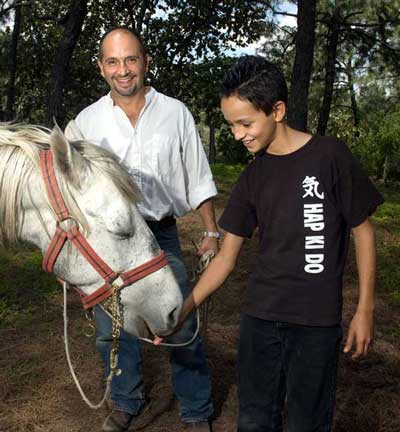 |
“I prefer older horses as they are usually gentler,” said Dr. Herrera as he
prepared a saddle for a gray stallion named Lagarto.
|
This saddle was much simpler than what I’ve seen charros using and the therapist explained that it’s
specially designed to put patients into closer contact with the horse and to
oblige them to maintain their balance. I noticed that the saddle had no stirrups
and the rider holds on to two rope “handles” rather than a saddle horn.
|
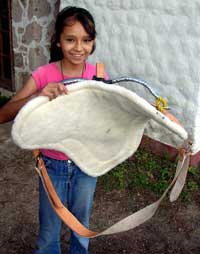 |
As Dr. Herrera’s youngest daughter Andrea mounted Lagarto, he explained that
riding a horse with this kind of saddle stimulates many of the muscles used for
walking and for equilibrium. It seems riding helps people who can’t walk, stroke
victims, people with cerebral palsy, dyslexia and even digestive problems.
Horseback Riding and Self-Confidence
Psychologically, riding and controlling a large animal like a horse gives people
self-confidence, especially people who are depressed and stuck in a mental rut.
Supposedly, both hemispheres of the brain are stimulated in Equine-Assisted
Psychotherapy.
As an English teacher, I was particularly surprised to learn that well cadenced
horseback riding is also considered an effective way of treating speech and
language problems because it apparently affects the physiological systems
involved in speaking.
I asked Dr. Herrera about his own experiences since he began practicing
Hippotherapy. “I’ve worked mainly with children,” he replied, “hyperactive
youngsters, some with attention-deficit syndrome and one with Down syndrome.
I’ve see rapid changes in all these patients. Their parents tell me they see
improvements in attitude, motivation, general happiness, etc.”
| During the training session I attended, each of Dr. Herrera’s children rode each
of his three horses around a circular route. In some cases, they were told to
lean forward or backward or to ride with their hands in the air. When each horse
finished its turn, it was given a carrot by one of the children. The friendliest
horse was Lagarto, who hung around afterwards, nuzzling each one of us.
|
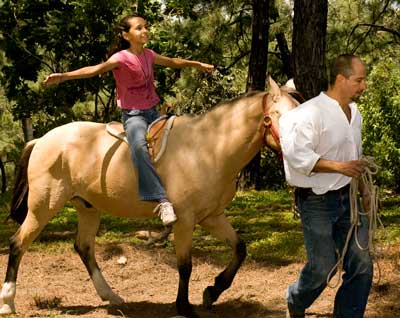 |
Hippotherapy Benefits the Horse
“Which of these horses do you think was the most aggressive when I first got
them?” asked Dr. Herrera.
Naturally, I guessed it was Lagarto, who was now the gentlest. “But why?” I
asked.
“Around here, when horses get old, they are often considered useless and
consequently receive very little food. All three of these horses were
undernourished when I got them, but the saddest thing was what they had done to
Lagarto. The previous owner decided to teach him to dance—and he did learn how
to dance—but the “training” was done by brutally beating the horse. Now all
three of these horses have got back their proper weight and, as you can see,
Lagarto has become the most affectionate.”
Well, this I thought was extraordinary. Equine-Assisted Psychotherapy seems not only to benefit
the patient, but also the horse: a win-win situation all around.
Riding Horses in el Bosque de la Primavera
Dr. Pepe Herrera also rents out his horses to anyone
interested in riding along trails in the Primavera Forest (Bosque de la
Primavera). Several of these trails begin near Herrera's ranch, located just
south of La Venta del Astillero, about 12 kilometers from Guadalajara's western
Periférico (Ring Road).
| ..."This is one of
the most beautiful parts of the Bosque, with stunning woods and deep,
dramatic canyons" says Herrera, "but few people even know of this area
because access is through private property. Visitors who come out here to
ride along these trails, usually feel like they have the entire forest to
themselves."
Alex Gesheva on
the edge of Lagarto's Lookout in El Bosque de la Primavera.
|
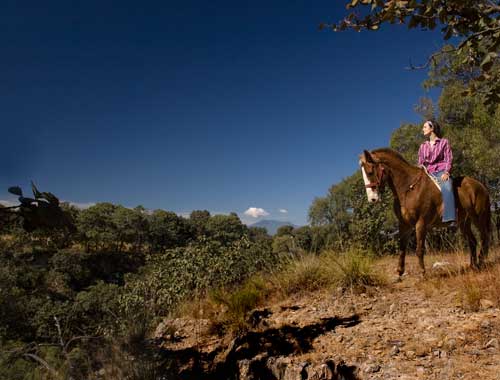 |
People who have ridden Dr. Herrera's horses along these
trails remark on the gentleness of his horses. "When you rent horses you never
know what you're going to get," says Susan Street of Pinar de la Venta, "but
because all of these horses are also used for therapeutic riding, I know I'll be
riding a mount that's not aggressive or easy to spook."
If you’re interested in Equine-Assisted Psychotherapy or just plain horseback riding for fun, you can reach Dr. Pepe Herrera at 044 331
410 0990 (his cell phone) and, yes, he does speak English.
SOME BENEFICIARIES OF EQUINE-ASSISTED
PSYCHOTHERAPY

Luis Benjamin Mendoza of Autlan rides a horse named
Indio in a demonstration of Equine-Assisted Psychotherapy at the 2010 Jalisco
Expo Ganadera (Livestock Fair) in Guadalajara . Therapist (on foot): Dr. Pepe
Herrera, aided by his son Bernardo (mounted). Luis was paralyzed after an
automobile accident, but regained the use of his limbs thanks to this therapy.






